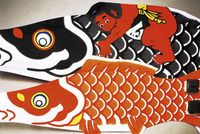

Total:131items
- Pottery & Porcelain (18)
- Lacquerware (4)
- Glasswork (2)
- Wood & Bamboo Work (19)
- Leather Work (1)
- Papermaking (13)
- Textile (20)
- Touzan-Ori: Touzan Weaving
- Sakai Gogatsu Koinobori: Sakai May Carp Streamer
- Nanbu Sakiori
- Nihon Shishu: Japanese Embroidery
- Tsuzurenishiki-Ori: Tsuzurenishiki Weaving
- Ojiya-Tsumugi: Ojiya Pongee
- Ise-Momen: Ise Cotton
- Ojiya-chijimi: Ojiya Crepe
- Yanai-jima: Yanai Stripes
- Kogin-zashi: Kogin embroidery
- Tamba Momen: Tamba Cotton
- Awa Shijira-ori: Awa Shijira Weaving
- Saga Nishiki: Saga Brocade
- Shinshu-Tsumugi: Shinshu-Pongee
- Kyo-nui: Kyoto Embroidery
- Noto Jofu: Noto-jofu hemp fabric
- Matsusaka Momen: Matsusaka Cotton
- Murayama Oshima Tsumugi
- Nibutani-attus
- Oku-Aizu Showa Karamushi Ori: Oku-Aizu Showa Ramie Textiles
- Dyeing products (5)
- Masonry (1)
- Metal Work (11)
- Stationery (4)
- Livingware (3)
- Accessory (4)
- Toys & Entertainment (14)
- Interior (2)
- Other crafts (10)

 |
Main Production Site:Osaka |
 《Characteristics》
《Characteristics》Sakai Gogatsu Koinobori (Sakai May Carp Streamer) has the characteristic design with Kintaro, a folk hero from Japanese folklore, riding on it. It is drawn one by one by hand on cotton textile. This carp streamer is popular because of its gradational and shading colour, as well as the delicate yet vigorous brushstrokes.
With dozens of various brushes, such as bamboo brushes, the carp streamer is coloured with pigment deliberately by hand. Sakai Gogatsu Koinobori is all handmade and its technique is carried over generation to generation until today.
No matter how many times have come and gone, we need to keep this tradition fostered by the Japanese history and climate, and hand it down by continuing the production of what can only be expressed with handcraft.
The traditional techniques are still kept by our craftsmen.
[A Designated Traditional Craft by Osaka Prefecture]
Source: Osaka Prefect. Gov., Dep. of Commerce and Industry
Translation by: Hanae Sano
| Materials | Cotton, imported colouring etc |
|---|---|
| Crafting Processes | 1. Cutting cotton cloths
Layer approximately 20 sheets of cotton cloth, put the original size of template with a weight on them, and then cut the cloths althgether. 2. Marking Drill eye, scales and head part and number the edge of the mouth which is a guideline for the trace of two sheets as one set. 3. Drawing eye part Draw eyes with a compass (“Bunmawashi”) and a brush. Bunmawashi: Fix the compass smaller than the actual size of eyes and draw them with a brush soaked with paint and paste. 4. Drawing head and bone part Draw the head and bone part alongside the drilled holes. 5. Draft Draw the scale, tail fin, pectoral fin and back fin along the trace. 6. Brushing Using the special brush, draw a fine line to spread it like a fan shape from the base of the scale. Draw the tail fin, pectoral fin, back fin and Kintaro’s hair in the same way. 7. Sewing Match the front and the back side and sew them up, while inserting the back fin. 8. Put eyes and muzzle Put the eyes made of aluminium plate. Divide the bamboo into 16 pieces and then plane off the corners. Then make them into a loop, sew it into the mouth and finish by adding the string to the mouth. |
| History | The custom, displaying a banner in front of houses on May 5 with the wishes of boy’s success in life, traces back around the mid-Edo period (17th century).
Gizaburou Takada, who run the toy and stationary business in Sakai-City, started selling the paper carp craft with the idea of paper carp craft which was made in Nagoya in the early Meiji period (1868-1912). This is the origin of the Sakai Gokatsu Koinobori. By the mid-Meiji priod, the production technique with the currently-used materials was established. |
◆Exhibition / Showcase
Sakai Gogatsu Koinobori Koubo (Sakai May Carp Streamer Workshop) :Takagi (Takada Shoten)
(Designated as Sakai Machikado Museum)
Opening hours: 10:00am-5:00pm
Closed: Irregular holidays
Admission Fee: Free
Address: 3-413 Terafunaocho-Higashi, Nishi-ku, Sakai, Osaka, 592-8341
TEL&FAX: 072-263-2205
◆Event Information
Carp Craft Workshop
Sakai Gogatsu Koinobori Koubo (Sakai May Carp Streamer Workshop) :Takagi (Takada Shoten)
Address: 3-413 Terafunaocho-Higashi, Nishi-ku, Sakai, Osaka, 592-8341
TEL&FAX: 072-263-2205
At the workshop, you can draw the carp on the cotton with a bamboo brush and an ink brush.
Fee: 3000 Yen (Booking prior to 1 month is necessary) February to April there is no workshop available.



